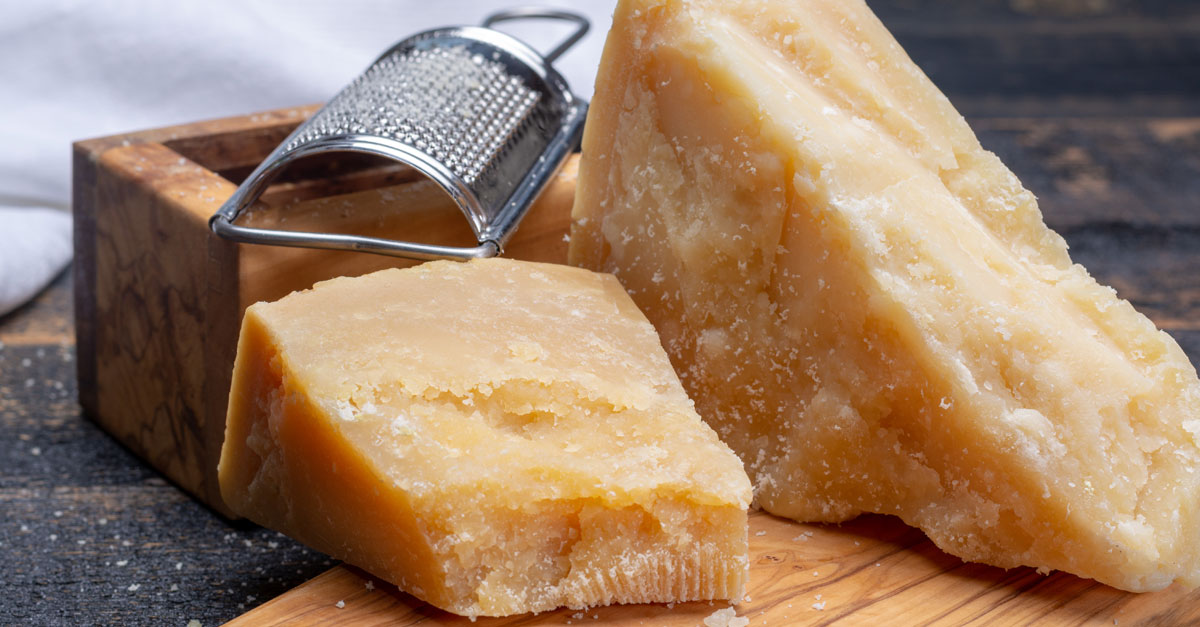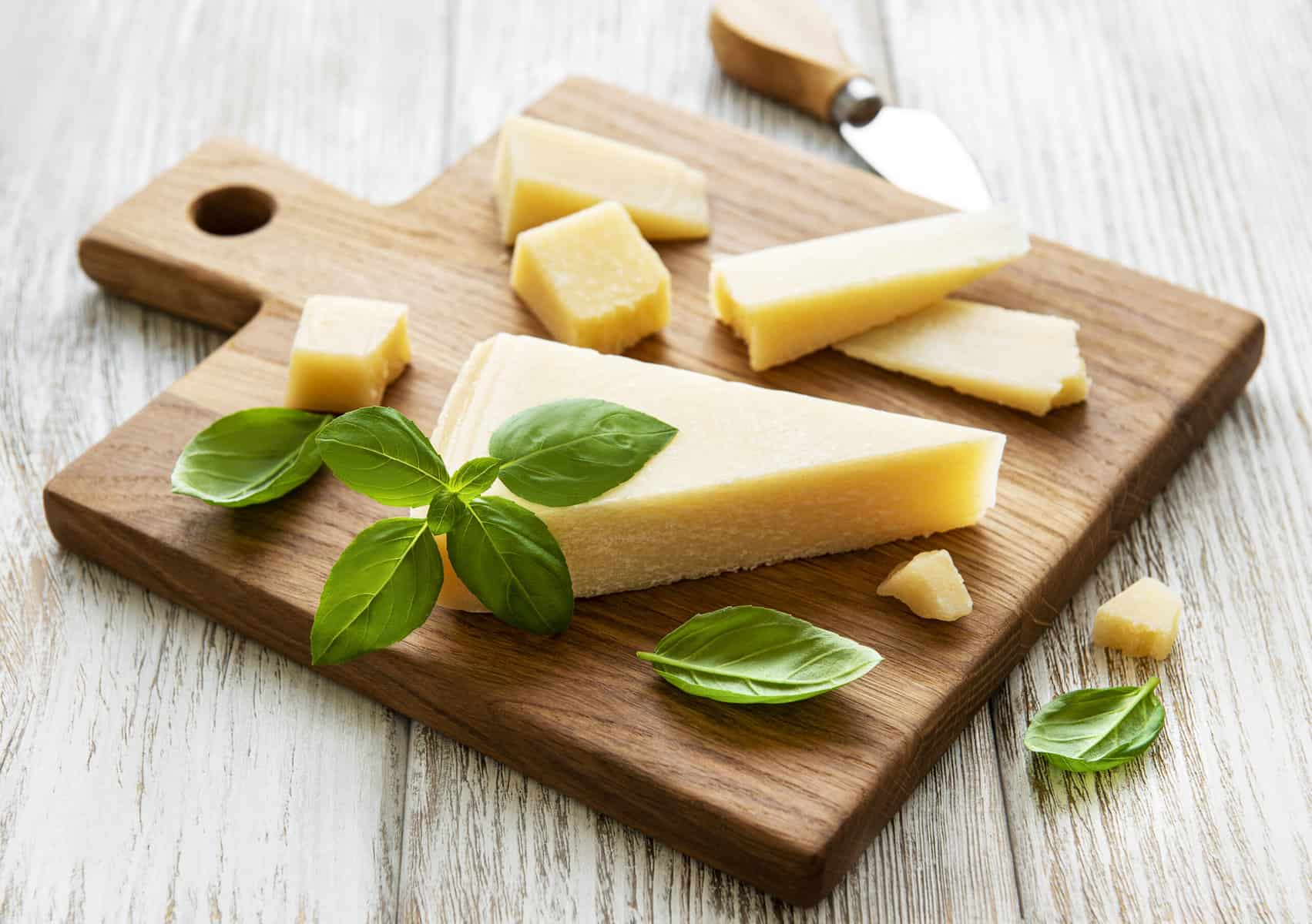Introduction To Asiago Cheese And Parmesan

Asiago cheese and Parmesan are both popular Italian cheeses, known for their rich flavors and versatility in cooking.
Asiago cheese, hailing from the Asiago Plateau in northern Italy, is made from cow’s milk. It has a flavor that is similar to Parmesan but with nuttier and creamier notes. Fresh Asiago cheese is semi-soft and mild, while aged Asiago develops a sharper flavor. It can be enjoyed on its own or grated over pasta, pizza, or salads.
Parmesan cheese, or Parmigiano-Reggiano, is produced in the regions of Parma, Reggio Emilia, Modena, and parts of Bologna and Mantua in Italy. It is made from cow’s milk and has a distinct savory and slightly fruity flavor. Parmesan is known for its hard and granular texture, making it ideal for grating over pasta, risottos, and soups.
Both Asiago and Parmesan cheeses bring a delightful taste to any dish and are indispensable in Italian cuisine.
Introduction To Asiago Cheese
Asiago cheese is a popular Italian cheese made from cow’s milk and hails from the Asiago Plateau in northern Italy. It is known for its rich and distinctive flavor, which is similar to Parmesan but with nuttier and creamier notes. Fresh Asiago cheese is semi-soft and mild, while aged Asiago develops a sharper taste. It is a versatile cheese that can be enjoyed on its own or grated over various dishes, such as pasta, pizza, or salads. Asiago cheese adds a delightful and unique taste to any meal, making it a favorite in Italian cuisine.
Introduction To Parmesan Cheese
Parmesan cheese is another well-known Italian cheese that is made from cow’s milk. It originated in the region of Emilia-Romagna in Northern Italy and is known for its distinct savory and nutty flavor. Parmesan cheese is often aged for a minimum of 12 months, which creates a hard and crumbly texture. It is commonly grated over dishes such as pasta, salads, and soups, adding a rich and savory taste. Parmesan cheese is a staple in Italian cuisine and is loved for its bold and robust flavor.
Asiago Cheese Characteristics

Asiago cheese is characterized by its semi-soft and mild texture, which becomes more firm and dry as it ages. It has a distinct sweet and nutty flavor that adds depth to dishes. Fresh Asiago is creamy and less sharp, while aged Asiago develops a sharper flavor profile. It is often grated over pasta, pizza, or salad, enhancing the overall taste with its savory notes. The versatility of Asiago cheese makes it a great ingredient to elevate a variety of recipes, especially those that showcase the flavors of spring, like a Spring Pea Risotto.
Asiago Cheese Flavor And Texture
Asiago cheese is known for its distinct flavor and texture. It has a creamy and slightly buttery taste with a nutty undertone. The flavor becomes more pronounced and intense as the cheese ages. The texture of Asiago cheese varies depending on its age. Young Asiago cheese has a semi-soft and smooth texture, while aged Asiago cheese becomes firmer and more crumbly. The aged varieties also develop a slightly granular texture. Overall, Asiago cheese provides a delightful combination of creamy richness and a subtle hint of nuttiness, making it a versatile and flavorful choice for various dishes.
Asiago Cheese Aging And Varieties
Asiago cheese is available in various ages and varieties, each offering a unique flavor and texture. The aging process plays a crucial role in developing the distinct characteristics of Asiago cheese. The aging period ranges from 1 to 18 months, with longer aging resulting in a more intense and robust flavor. The different varieties of Asiago cheese include:
- Fresh Asiago: This is the youngest and mildest version of Asiago cheese, aged for about 20 to 40 days. It has a creamy, smooth texture and a mild flavor.
- Mezzano Asiago: Aged for about 6 to 12 months, this variety has a firmer texture and a slightly stronger flavor compared to fresh Asiago.
- Asiago d’Allevo: Aged for a minimum of 10 months, this cheese has a crumbly texture and a richer, nuttier flavor profile.
- Asiago Vecchio: This is the aged version of Asiago, aged for at least 18 months. It has a firm and granular texture and a bold, complex flavor with distinct nutty and tangy notes.
Overall, the aging process enhances the flavor and texture of Asiago cheese, offering a range of options to suit different culinary preferences.
Parmesan Cheese Characteristics

Parmesan cheese is known for its unique characteristics that make it a beloved choice in Italian cuisine. It has a sharp and intense flavor profile, with fruity and savory notes that add depth to dishes. Parmesan has a granular texture, which is a result of its long aging process. The cheese is dry and crumbly, making it easy to grate and sprinkle over dishes. It also has a distinct earthiness that adds complexity to recipes. Parmesan cheese is versatile and can be used in a wide range of dishes, from pasta to salads to soups. Its strong flavor and texture make it a standout ingredient in many Italian recipes.
Parmesan Cheese Flavor And Texture
Parmesan cheese is known for its unique flavor and texture that sets it apart from other cheeses. It has a sharp and intense flavor profile with fruity and savory notes that add depth to dishes. The cheese also has a distinct earthiness that adds complexity to recipes. Parmesan cheese has a granular texture, which is a result of its long aging process. It is dry and crumbly, making it easy to grate and sprinkle over dishes. The combination of its strong flavor and texture makes Parmesan cheese a standout ingredient in many Italian recipes.
Parmesan Cheese Aging And Varieties
Parmesan cheese undergoes a lengthy aging process, which contributes to its distinct flavor and texture. It is typically aged for a minimum of 12 months, although some Parmesan cheeses are aged for up to 36 months. The aging process allows the cheese to develop its rich, nutty flavors and firm, granular texture.
There are also different varieties of Parmesan cheese available. The most well-known is Parmigiano Reggiano, which is produced in a specific region of Italy and follows strict production regulations. Other varieties, such as Grana Padano and Reggianito, have similar characteristics but may vary slightly in flavor and texture.
Cooking With Asiago And Parmesan

Asiago and Parmesan are both versatile cheeses that can elevate the flavor of various dishes. When it comes to cooking with Asiago, it pairs well with pasta, risotto, and salads, adding a rich and creamy taste. It also melts beautifully, making it perfect for gratins and sauces. Parmesan, on the other hand, is a staple in Italian cuisine and is commonly used in pasta dishes, soups, and salads. Its sharp and robust flavor adds depth to any recipe. Whether you’re making a classic pasta dish or experimenting with new flavors, both Asiago and Parmesan cheeses are essential ingredients to have in your kitchen.
Recipes Using Asiago Cheese
Asiago cheese adds a creamy and tangy flavor to a variety of dishes. One delicious recipe to try is Asiago-stuffed chicken breast. Simply slice a pocket into the chicken breast and stuff it with grated Asiago cheese, fresh herbs, and breadcrumbs. Another tasty option is Asiago and mushroom risotto, where the richness of the cheese complements the earthiness of the mushrooms. For a quick and easy appetizer, serve sliced baguette topped with melted Asiago cheese and a drizzle of honey. These recipes showcase the versatility of Asiago cheese and its ability to enhance the flavors of any dish.
Recipes Using Parmesan Cheese
Parmesan cheese is a versatile ingredient that can be used in various recipes to add a rich and savory flavor. One popular dish is classic spaghetti carbonara, which combines cooked pasta with crispy bacon, eggs, and Parmesan cheese for a creamy and delicious sauce. Another delicious option is homemade garlic bread, where grated Parmesan is mixed with butter and garlic, spread on sliced baguette, and baked until golden and crispy. Parmesan can also be sprinkled on top of salads, roasted vegetables, or used as a garnish for soups. Its nutty and salty taste adds a delightful touch to any dish.
Comparison Between Asiago And Parmesan

Asiago and Parmesan are both popular Italian cheeses, but they have distinctive characteristics that set them apart. In terms of flavor profile, Asiago cheese is slightly more buttery, creamy, and nutty, with a noticeable bitterness in certain varieties. On the other hand, Parmesan tends to be sharper and more robust, with fruity and savory notes and a distinct earthiness. While they can be used interchangeably in some recipes, their different flavor profiles make them better suited for specific dishes. Overall, both cheeses offer unique and delicious options for enhancing various dishes.
Asiago Vs Parmesan: Flavor Profile
Asiago and Parmesan cheese have distinct flavor profiles that set them apart. Asiago cheese is known for its slightly buttery, creamy, and nutty taste, with certain varieties having a noticeable bitterness. On the other hand, Parmesan cheese offers a sharper and more robust flavor, with fruity and savory notes and a distinct earthiness. Parmesan, especially fully aged Parmigiano Reggiano, contains traits that are characteristic of umami flavor. Both cheeses add unique and delicious flavors to dishes, making them versatile options in the kitchen.
Asiago Vs Parmesan: Culinary Uses
Asiago and Parmesan cheese bring their unique flavors to a variety of culinary creations. Asiago cheese enhances the taste of pasta dishes, risottos, and soups, adding a creamy and slightly nutty flavor. It can also be used as a topping for salads or melted on sandwiches. Parmesan cheese, with its sharp and robust flavor, is perfect for grating over pasta, salads, and roasted vegetables. It is also a key ingredient in traditional Italian dishes such as risotto, pizza, and pesto sauce. Both cheeses can elevate the taste of your favorite recipes and add a deliciously savory element to your meals.
Conclusion And Recommendations

In conclusion, Asiago cheese and Parmesan cheese each bring their distinct flavors and characteristics to the table. Asiago offers a creamy, slightly nutty taste, while Parmesan has a sharper, more robust flavor. Both cheeses are versatile and can be used in a variety of recipes, enhancing the taste of pasta dishes, risottos, and soups. Additionally, they are perfect for grating over salads, roasted vegetables, and pizza. For those looking to add a deliciously savory element to their meals, both Asiago and Parmesan cheeses are excellent choices. Experiment with recipes and explore the unique flavors that these Italian cheeses have to offer.
Dishes To Try With Asiago And Parmesan
Asiago and Parmesan cheese are both versatile ingredients that can elevate the flavors of many dishes. Here are some delicious recipes to try with Asiago and Parmesan:
- Pasta dishes: Add grated Parmesan or chopped Asiago cheese to your favorite pasta dishes, such as spaghetti carbonara or fettuccine Alfredo, for a savory and creamy enhancement.
- Risottos: Both cheeses work beautifully in risottos. The nutty flavor of Asiago adds depth to mushroom or butternut squash risotto, while Parmesan brings a sharpness to classic risotto Milanese.
- Soups: Sprinkle grated Asiago or Parmesan on top of creamy soups like tomato, broccoli, or potato for an extra layer of flavor.
- Salads: Shave slices of Asiago or sprinkle grated Parmesan on top of salads to add a rich and tangy element.
- Pizza: Both Asiago and Parmesan make great toppings for pizzas. The strong flavor of Parmesan pairs well with tomato-based pizzas, while the milder Asiago can complement a variety of toppings.
Experiment with these dishes and discover the unique taste that Asiago and Parmesan bring to your meals. Enjoy the richness and depth of flavor that these Italian cheeses offer.
Final Thoughts On Asiago Cheese Vs Parmesan
In conclusion, both Asiago cheese and Parmesan are exceptional Italian cheeses that bring unique flavors and characteristics to the table. While Asiago has a nuttier and creamier profile, Parmesan is sharper and more robust. Both cheeses can be used in a variety of dishes, from pasta to soups and salads. The choice between Asiago and Parmesan ultimately depends on personal preference and the specific flavor profile desired. Regardless of which cheese you choose, these Italian classics are sure to add depth and richness to your culinary creations. So go ahead and indulge in the delicious world of Asiago and Parmesan cheeses.
FAQ About Asiago Cheese Vs Parmesan: Italian Cheese Showdown
Q: What is Asiago Cheese?
A: Asiago cheese is a cow’s milk cheese that originated in the Asiago plateau in the Veneto region of Italy. It comes in two varieties: fresh and aged.
Q: What is Parmesan Cheese?
A: Parmesan cheese, also known as Parmigiano-Reggiano, is a hard, granular cheese made from cow’s milk. It is famous for its nutty and salty flavor.
Q: How do Asiago and Parmesan differ in taste?
A: Asiago cheese has a smoother and milder flavor compared to Parmesan. Parmesan has a sharper, nuttier taste with a stronger umami flavor.
Q: Can Asiago and Parmesan be used interchangeably in recipes?
A: While both cheeses can be used in similar dishes, they have distinct flavors and textures. Parmesan is often grated over pasta dishes, while Asiago melts beautifully in sauces.
Q: Which cheese is better for melting?
A: Asiago cheese is known for its excellent melting properties, making it great for dishes like grilled cheese sandwiches and casseroles. Parmesan can also melt, but it’s more commonly used as a topping.
Q: Are Asiago and Parmesan suitable for vegetarians?
A: Both Asiago and Parmesan are typically made with animal rennet, which is not vegetarian-friendly. However, some producers offer vegetarian-friendly versions made with microbial rennet.

Kostas Mediterranean is a family-owned Greek restaurant located in North Vancouver. Our passion for bringing the authentic flavors of Greece to the local community has been the driving force behind our establishment. We take pride in offering a warm and welcoming atmosphere where guests can experience the true essence of Greek hospitality. Our journey began with Kostas, whose culinary skills and love for Greek cuisine inspired the creation of the restaurant. With a desire to share his family recipes and traditions, Kostas set out to create a dining experience that captures the spirit of Greece. The result is a menu that showcases a delightful blend of traditional and modern Greek dishes prepared with the finest and freshest ingredients.